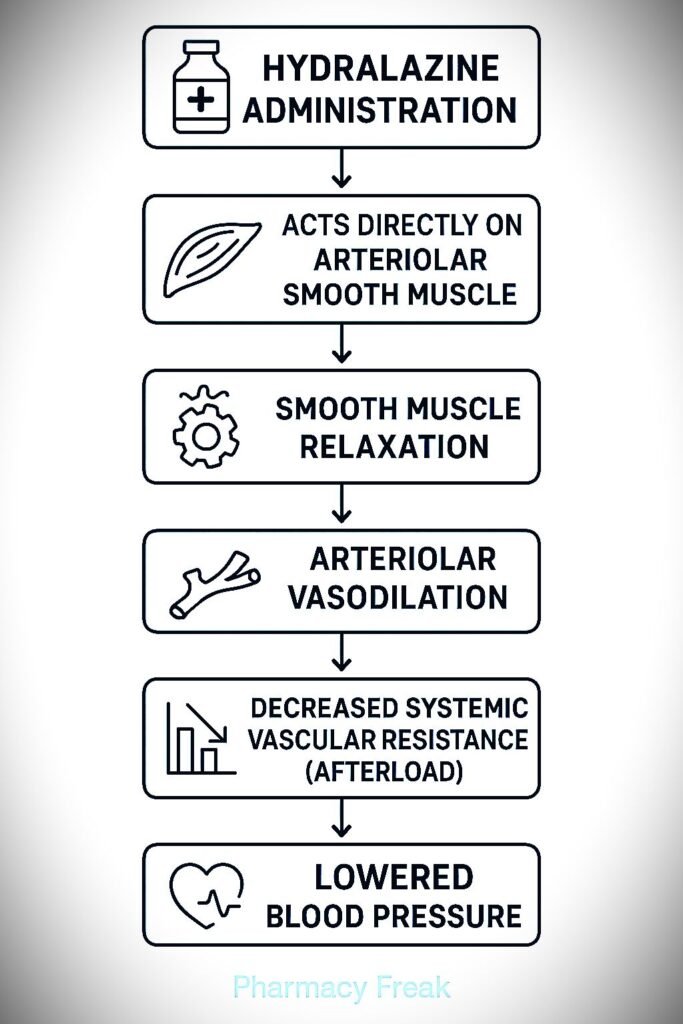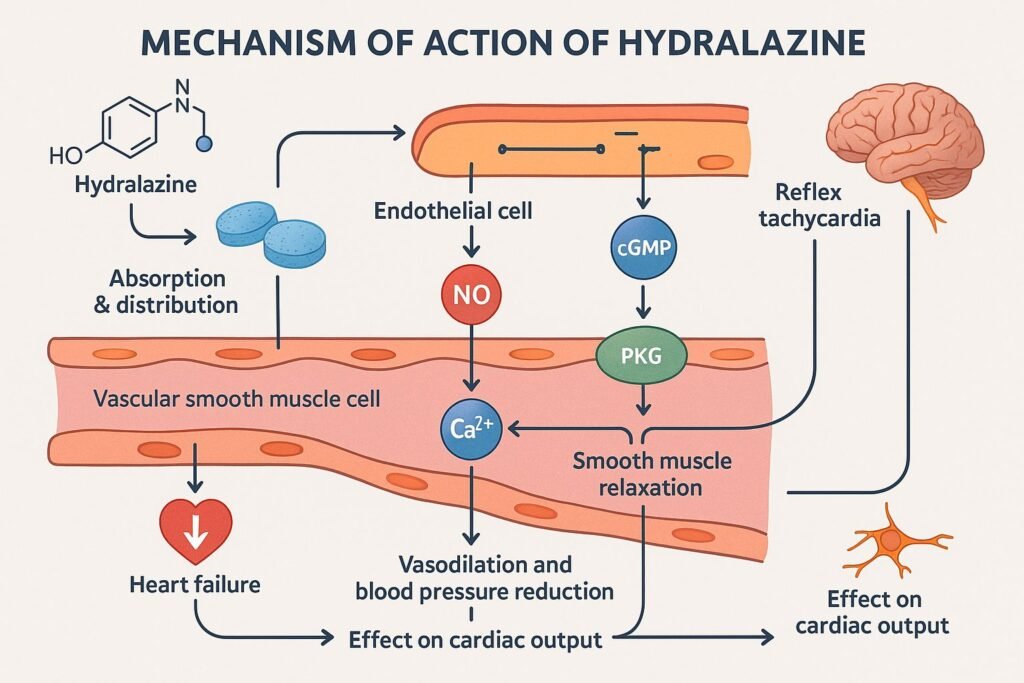Table of Contents
Introduction
Hydralazine is a potent vasodilator used primarily in the management of hypertension and heart failure, particularly in patients intolerant to ACE inhibitors or with resistant hypertension. It acts directly on vascular smooth muscle, causing arterial dilation and thereby reducing both afterload and cardiac workload. Its rapid onset and efficacy make it valuable in acute hypertensive crises and chronic therapy.
Step-by-Step Mechanism of Action
- Direct Arteriolar Smooth Muscle Relaxation
Hydralazine preferentially dilates arterioles (resistance vessels) rather than veins, reducing peripheral vascular resistance, systemic blood pressure, and cardiac afterload. - Interference with IP₃-Mediated Calcium Release
It impairs inositol triphosphate (IP₃)-induced release of calcium from the sarcoplasmic reticulum in vascular smooth muscle, limiting contraction. - Opening of Potassium Channels
Activates K\⁺ channels, causing hyperpolarization of smooth muscle membrane and reducing calcium influx through voltage-dependent L-type channels. - Decreased Intracellular Calcium
The combined IP₃ inhibition and membrane hyperpolarization result in reduced intracellular calcium, preventing smooth muscle contraction and promoting vasodilation. - Reflex Sympathetic Activation
The fall in blood pressure leads to reflex tachycardia and increased renin release. Co-administration of β-blockers and diuretics is often required to blunt these responses.

Pharmacokinetic Parameters
| Parameter | Value |
|---|---|
| Bioavailability | ~50–60% (extensive first-pass hepatic metabolism) |
| Onset of action | 5–15 minutes (oral), 5–20 minutes (IV) |
| Peak effect | 30–60 minutes |
| Half-life | ~3–7 hours (variable due to hepatic acetylation) |
| Metabolism | Hepatic via N-acetyltransferase—fast and slow acetylators vary |
| Excretion | Renal (primarily as metabolites) |
| Monitoring | No routine labs; blood pressure and heart rate only |
Clinical Uses
- Essential hypertension (in combination therapy)
- Hypertensive emergencies (IV hydralazine)
- Heart failure in combination with nitrates (especially in African‑American patients)
- Pregnancy-induced hypertension (safe in second and third trimesters)
Adverse Effects
- Reflex tachycardia, palpitations
- Fluid retention (edema)
- Headache, flushing
- Lupus-like syndrome (arthralgia, rash, positive ANA—more common in slow acetylators)
- Nausea and constipation
- Rare: peripheral neuropathy, blood dyscrasias
DIAGRAM OF MOA OF HYDRALAZINE

Comparative Analysis
| Parameter | Hydralazine | Nitroprusside | Minoxidil |
|---|---|---|---|
| Primary target | Arterioles | Both arterioles & veins | Arterioles |
| Onset of action | Moderate | Rapid (minutes) | Moderate |
| Chronic use risk | Drug-induced lupus | Cyanide toxicity | Hirsutism |
| Preferred use | Chronic hypertension with β-blockers | Hypertensive crisis | Resistant hypertension |
MCQs
1. Hydralazine primarily acts by causing dilation of which blood vessels?
a) Veins
b) Arterioles
c) Capillaries
d) Lymphatics
Answer: b) Arterioles
2. Which of the following mechanisms contributes to hydralazine’s effect?
a) Inhibits angiotensin II
b) Blocks IP₃-mediated Ca²⁺ release
c) Enhances α₁-adrenergic tone
d) Activates L-type Ca²⁺ channels
Answer: b) Blocks IP₃-mediated Ca²⁺ release
3. A common adverse effect of hydralazine is:
a) Thrombocytopenia
b) Lupus-like syndrome
c) Hyperkalemia
d) Gynecomastia
Answer: b) Lupus-like syndrome
4. Why is hydralazine often given with a β-blocker?
a) Improve first-pass metabolism
b) Prevent reflex tachycardia
c) Enhance diuretic effect
d) Prevent lupus reaction
Answer: b) Prevent reflex tachycardia
5. Hydralazine is safe for use during pregnancy because:
a) It crosses the placenta
b) It has teratogenic effects
c) It does not significantly cross placenta
d) It causes fetal hypotension
Answer: c) It does not significantly cross placenta
FAQs
1. Can hydralazine be used in pregnancy?
Yes, it’s considered safe for second and third trimester hypertension.
2. Why monitor heart rate when using hydralazine?
Reflex tachycardia can lead to arrhythmias; β-blockers help manage this.
3. What is the cause of hydralazine-induced lupus-like syndrome?
It’s immune-mediated; more common in slow acetylators.
4. Can hydralazine be used for acute heart failure?
Yes, often combined with nitrates to reduce preload and afterload.
5. Does hydralazine require lab monitoring?
No routine labs; monitor blood pressure and symptoms only.
References
- Goodman & Gilman’s The Pharmacological Basis of Therapeutics, 13th Edition.
- KD Tripathi. Essentials of Medical Pharmacology, 8th Edition.
- https://pubmed.ncbi.nlm.nih.gov/11601633/
- https://pubmed.ncbi.nlm.nih.gov/16635467/

I am pursuing MBA in pharmaceutical management from NIPER Hyderabad with a strong academic record and proven success in national-level pharmacy entrance exams. I secured AIR 61 in NIPER 2024 (MS/M.Pharm) and AIR 27 in NIPER MBA, along with AIR 147 in GPAT 2024 and AIR 907 in GPAT 2023. I also achieved AIR 6 in AIIMS CRE-2025 for Drug Store Keeper and was selected as a Pharmacist (AIR 61) for ESIC. Additionally, I was the Runner-Up in Round 2 of the EY Case Study Competition.
At PharmacyFreak.com, I aim to guide future pharmacists through expert content, exam strategies, and insightful resources based on real experience and academic excellence.
Mail- harsh@pharmacyfreak.com
